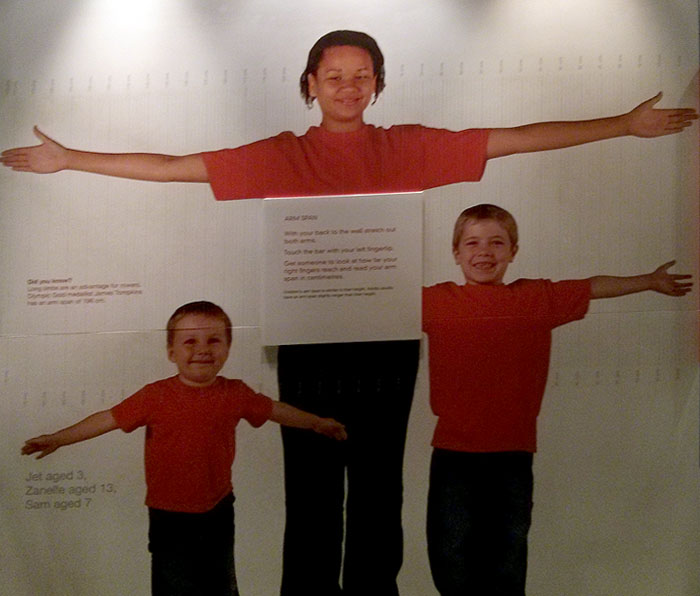I recently took my family to Scienceworks interactive museum of science and technology in Melbourne. The kids are huge fans of Scitech, a similar place in our home town Perth, so we knew it would be an exciting day out. One of the biggest attractions at Scienceworks was the Sportsworks display.

Sportsworks has a lot of cool interactive displays related to sports, but I was most interested in the fitness testing section, which allows the visitor to test and measure themselves and learn about their own abilities.
The Sportsworks fitness assessment is a self-guided activity, including a recording booklet which directs you through each of the tests. It starts, as all good testing protocols should, with the standard anthropometric measurements. You measure your own height and weight, though there is no guarantee of the accuracy of the scales (or any other measurement device in the display). Even if they are calibrated regularly, the constant high use means it probably won’t stay that way for long.
The simple measure of arm span was measured against a marked wall. I always like to compare arm span to height to determine proportion.
Proportion is also assessed with a hand span test, and comparing your hand size to that of an Australian champion rower.
The sit and reach test was used to test flexibility. There was no instruction to take off your shoes, which is not good for unsuspecting women in their high heels!
The balance test involved a type of wobbleboard (sorry no picture). You placed both feet on a board like a see-saw, and you tried to keep balanced without the ends touching the ground. It seemed too sensitive for most people, so scores were pretty low.
The reaction time test required you to press a stop button as soon as possible after another button lit up. It took several turns to determine the best score.
Explosive power was measured with the vertical jump test. Jumping off the plate and not having to touch a height, lead to a few different techniques. Again it was the best of three attempts.
Aerobic fitness (“heart fitness”) was measured with a step test. This one was a bit too complex for most people to complete correctly. After taking your resting heart rate, you were required to step up and down on a step (different sizes for adults and children), and then take your heart rate a minute after stopping by gripping on a sensor bar.
Upper body strength was measured with a pull test on some strain gauge. It really was not a true upper body strength test, as this technique utilises back and leg strength too.
The hand/eye coordination test was by far the most fun. You had to push each button on a grid as it lit up. We had to help our kids as they could not even reach the higher buttons – it was so tempting to help them at other times too!
Peripheral vision was tested too with the set-up shown below. You had to look straight ahead, then indicate at which point you don’t see the light as it moved out of your range of vision.
Hand grip strength was measured using a dynamometer. There was no instruction to adjust the handle to the size of your hand, an important thing to do for hand grip testing.
And finally there was a sprint speed test, which was not officially part of the fitness testing. You line up at the starting line of a 10 metre track, and then race against images of sprinter Cathy Freeman that light up along the wall next to you. Your time is posted above the track.

As with all fitness testing assessments, the test numbers on their own are not meaningful – the analysis and interpretation of the results are more important. After all the tests are completed, you can enter your sporting interests and key results, and a personalised report is printed for you with a summary of your results including a list of sports that you may be best suited to.
So overall it was a bit of fun, motivating for some people, and definitely a great introduction to sports science.













